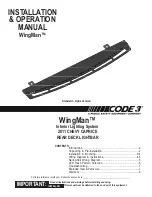
Torque Converter Clutch
A feature designed to improve fuel economy has been
included in the automatic transmission on your vehicle.
A clutch within the torque converter engages automati-
cally at calibrated speeds. This may result in a slightly
different feeling or response during normal operation in
the upper gears. When the vehicle speed drops or dur-
ing some accelerations, the clutch automatically
disengages.
NOTE:
•
The torque converter clutch will not engage, until the
transmission fluid and engine coolant are warm
[usually after 1 to 3 miles (2 to 5 km) of driving].
Because engine speed is higher when the torque
converter clutch is not engaged, it may seem as if
the transmission is not shifting properly when cold.
This is normal. Using the Electronic Range Select
(ERS) shift control, when the transmission is suffi-
ciently warm, will demonstrate that the transmission
is able to shift into and out of Overdrive.
•
If the vehicle has not been driven for several days,
the first few seconds of operation after shifting the
transmission into gear may seem sluggish. This is
due to the fluid partially draining from the torque
converter into the transmission. This condition is
normal and will not cause damage to the transmis-
sion. The torque converter will refill within five sec-
onds after starting the engine.
AUXILIARY SWITCHES — IF EQUIPPED
There can be up to six auxiliary switches located in the
lower switch bank of the instrument panel which can be
used to power various electronic devices and PTO
(Power Take Off) – If Equipped. If Power Take Off is
equipped, it will take the place of the sixth Auxiliary
switch. Connections to the switches are found under
the hood in the connectors attached to the auxiliary
Power Distribution Center.
You have the ability to configure the functionality of the
auxiliary switches via the instrument cluster display. All
switches can now be configured for setting the switch
type operation to latching or momentary, power source
of either battery or ignition, and ability to hold last state
across key cycles.
NOTE:
Holding last state conditions are met when switch type
is set to latching and power source is set to ignition.
For further information on using the auxiliary switches,
please refer to the Ram Body Builders Guide by access-
ing www.rambodybuilder.com and choosing the
appropriate links.
ACTIVE NOISE CANCELLATION
Your vehicle is equipped with an Active Noise Cancella-
tion system that cannot be turned off. This system is
designed to address exhaust and engine noise. The
system relies on four microphones embedded in the
headliner, which monitor exhaust and engine noise,
and assists an onboard frequency generator, which cre-
ates counteracting sound waves in the audio system’s
speakers. This helps keep the vehicle quiet at idle and
during drive. The system is deactivated when the win-
dows are rolled down.
FOUR-WHEEL DRIVE OPERATION —
IF EQUIPPED
Four-wheel drive trucks are equipped with either a
manually shifted transfer case or an electronically
shifted transfer case. Refer to the operating instruc-
tions for your transfer case, located in this section for
further information.
ELECTRONICALLY SHIFTED
TRANSFER CASE (EIGHT SPEED
TRANSMISSION) — IF EQUIPPED
This is an electronic shift transfer case and is operated
by the 4WD Control Switch (Transfer Case Switch),
which is located on the instrument panel.
Four-Position Transfer Case
STARTING AND OPERATING
181
5
















































